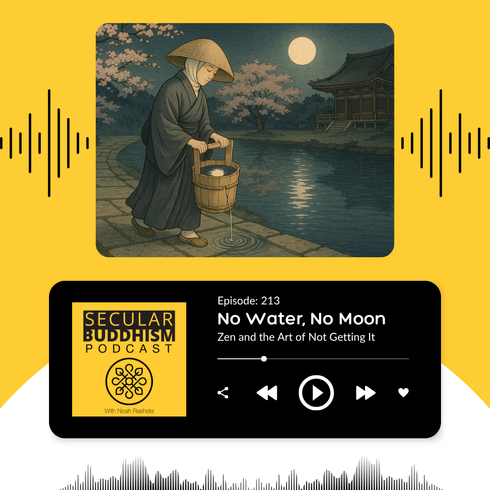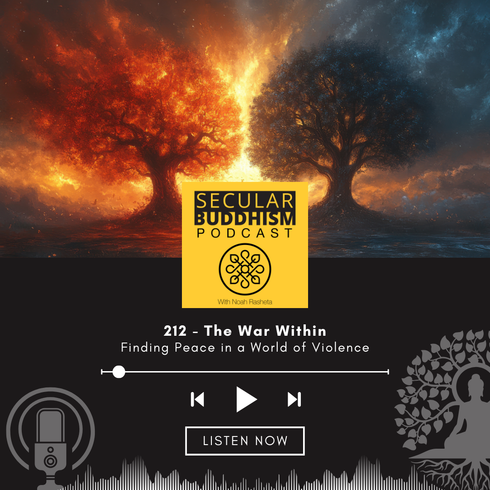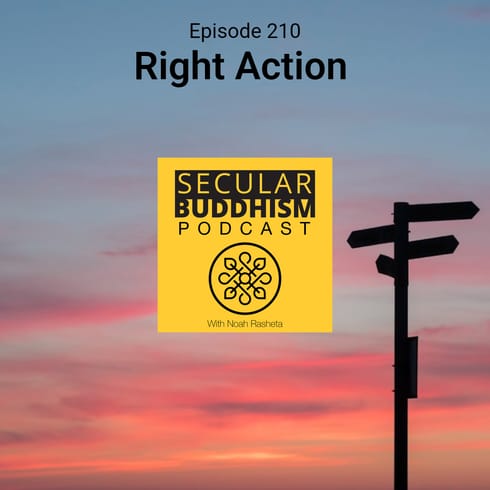
85 - Sometimes We Try Too Hard
Sometimes we fail because we try too hard, other times because don’t try hard enough. The trick is to find the right balance, the space in between, the space that is often referred to in Buddhism as The Middle Way. In this podcast episode, I will discuss the idea of the Middle way in terms of space and time.
Subscribe to the podcast on:
iTunes – https://itunes.apple.com/us/podcast/secular-buddhism/id1071578260
SoundCloud – https://soundcloud.com/secularbuddhism
TuneIn – http://tunein.com/radio/Secular-Buddhism-p823114/
Stitcher – http://www.stitcher.com/s?fid=80132&refid=stpr
Transcript:
Hello and welcome to another episode of the Secular Buddhism podcast. This is episode number 85. I am your host, Noah Rasheta. and today I’m talking about trying too hard, not trying hard enough, and the beauty of finding the middle way. Before I jump into that, keep in mind the Dalai Lama’s advice, “Do not use what you learn from Buddhism to be a Buddhist. Use it to be a better whatever you already are.”
Now one of the most important impacts Buddhism has had on my life is fully introducing me to this concept of the middle way. I want to start out talking about a story of a monk named Sona. This is a monk who was trying to be good at meditating, trying to live a more mindful life like many of us are trying to be better whatever we already are. In the Parable of the Lute, we learn about Sona becoming discouraged with his meditation practice, and he goes to visit the Buddha for advice. In the story, Sona, despite all the effort and energy he was putting into his practice, he grows discouraged and disappointed. His meditation practice that was supposed to be the very source of great peace and happiness and contentment in his life ends up being the very source of discontent for him. Sona had been taught to be mindful, even when walking, and he took this to heart to the point where he practiced so intensely that his feet developed blisters and he bled and he was getting discouraged. This wasn’t all it was cracked up to be for him.
When the Buddha heard about this, he went to see Sona, and he says, “I have heard that you are not getting the results you were hoping for from your meditation practice.” Supposedly, Sona at this point was considering just quitting the practice and going back to how life was before he had ever become a monk, and the Buddha reminded him that before becoming a monk, he was known for being a skilled lute player. He played the lute, a small guitar-like stringed instrument. Sona replied, “Yeah, I was able to produce good music.” Then the Buddha asks him, “Well, what happened when the strings were too tightly wound up?” Sona replied, “Well, couldn’t produce good music if the strings were too tight, and the strings could break.” The Buddha said, “Well, what happened when the strings were too loose?” Sona again replied, “Well, I couldn’t produce good music when they were too loose.”
In this simple exchange, the simple teaching, the Buddha helped Sona to understand that he had essentially been trying too hard, trying too hard to be mindful, trying too hard to do it the right way when there really isn’t a right way. The reminder here is that the skillful way to play the lute is with the strings that are not too tight and not too loose, and Sona understood this teaching. In the story, he decided to continue practicing. He found his middle way and went on to become enlightened, as it so often happens in these stories.
I love this story, particularly becomes … It seems to be incredibly profound and yet such a simple teaching. We are like the lute, and we have that middle way where the strings are not too tight and they’re not too loose. We’re not trying too hard. It’s somewhere in between. We’re trying too hard and we’re not trying hard enough. You can think of this concept when applied to anything in your life. Not just mindfulness practice, but think of this as a partner, as a spouse, as a parent. I’m sure all of you know a parent that seems to be trying too hard or you know parents who just don’t seem to be trying hard enough or coworkers or your boss or anyone in almost any aspect of life. You can identify someone who seems to be trying too hard or not trying hard enough.
I’m sure with some, a little bit of self-reflection, introspection, you could identify this about you as well, but here’s the catch. It’s not about identifying this in others. This teaching, the Buddha didn’t come and say, “Oh, tweak those strings a little bit, three centimeters to the left.” It wasn’t that. The whole teaching was to understand that you are the lute. You are the lute and you are also the lute player, and only you can discover that middle way, your middle way. Only you can ask yourself honestly, “Am I trying too hard or am I not trying hard enough?” That’s part of this quest. That’s what this mindfulness practice is about. In Sona’s case, it wasn’t working for him because he was trying too hard.
Now for me, my entire journey with Buddhism and mindfulness practice has been about finding my middle way, that place where I am at peace, the music seems to be playing just right, at least for me. But it can be difficult at times because we have this inner critic that thinks it knows all about music and how music should be played and how it should sound. That critic is heavily influenced by societal norms, religious and political views, and everything else that falls under the collective label of the conditioned mind. So, I want to share another analogy kind of exploring this whole topic of trying too hard. Really, this is the teaching of the middle way.
Imagine for a moment that you’re driving a car. I’m sure most of us listening have this experience of knowing what it is to be driving a car. Now when we’re driving a car, all of the inputs have to do with now, the present moment. Even though you’re looking towards the future, let’s call that looking through the windshield, you don’t actually start to turn the steering wheel until you are in the turn. If you get that timing wrong, you’re in big trouble. You don’t just say, “Oh, here comes a turn,” boom, I start turning. It would be highly unskillful. You wait. You see it coming, and then when you enter the turn, you do the inputs in the present moment. Anticipating a big turn, you can start slowing down now. That’s something that you’re doing in the present in anticipation of something that’s happening in the future, but, again, if you get the timing wrong, you’re in big trouble.
To me, this is the essential lesson of the middle way that is so often spoken of in Buddhist teachings. It’s the timing of everything we do in the present moment. I like to call this the eternal now. Many of us live our lives driving this car by looking through the rear view mirror, and, as you can imagine, this as highly unskillful. It can cause incredible, unnecessary suffering for ourselves and for others on the road when we drive this way.
Then there’s another aspect of this that I want to explore as part of the analogy. I’m sure you’ve experienced what it’s like to drive with a backseat driver. This is when you’re driving and someone is telling you where to turn, when to turn, slow down, speed up, or it could just come in the form of they’re just chatting, telling you a long drawn-out story when you’re trying to focus on driving and it’s distracting you from driving. I’m sure we’ve all experienced this to some degree or another or we’ve been that backseat driver.
But what I want to get at with this analogy is what if we understood that we are the backseat driver? That inner narrator, the thoughts that are so prevalent in our mind, the voice in our head, that is the backseat driver. I’m not saying that the backseat driver is wrong, that we need to eliminate the backseat driver. The backseat driver is sometimes right. It’s not about saying, “Okay, inner narrator, you are wrong.” That’s not the point. Before, we just assumed whatever the inner narrator says must be right. It’s not that. I think we evolved to have this inner critic, this inner narrator, as a survival mechanism. It’s trying to keep us safe, but that doesn’t mean it’s always right and that’s the important thing here. I’ve been driving at times where I’m grateful that someone yelled, “Hey, watch out. There’s a deer,” because I didn’t notice it, and thanks to the other voice, I was able to act skillfully and not hit the deer.
I’ve also had experiences where someone’s like, “Oh, no, watch out for that hole,” and I slow down, all freaked out and realize, What hole? There is no hole. It was dark and they couldn’t see, or they were half asleep and they just woke up and blurted something out. I’ve had that happen too. And that’s kind of like what happens in our mind. It’s not about deciding the voice is always right or the voice is always wrong. I think it’s more about understanding that it’s somewhere in between, sometimes right, sometimes wrong, and it takes a little bit of skill. Most of us go through our lives assuming that everything in our head is right. My thoughts, my beliefs, my memories, they’re all correct.
Quick side note on memories. In the last podcast episode, I told you guys about the experience with my wife and that message of trying to go to Antarctica. Well, I was sharing that with her and turns out she has an entirely different memory of how that all played out. It wasn’t Antarctica. It was Africa. Just the details were all different, and it was really funny. We started laughing as we were comparing our notes and then we laughed, saying, “Well, the memory is probably somewhere in between the two,” between my memory and hers. That brings about this whole other lesson that can be had, which is don’t trust your own memories. They’re not always right. I’ve experienced this multiple times with my twin brother when we recall past stories where we know we were both there, but we both recall the experience slightly differently. Again, that could be a whole nother podcast episode, but the lesson is don’t believe your own thoughts all the time. They may be wrong.
I think that’s exactly what this lesson is trying to get us to understand is that that voice in our mind may be wrong, it may be right, and what if we could live with that uncertainty of sometimes we don’t know? We see that the middle way is about understanding this Parable of the Lute and the strings, whether or not they’re too tight or they’re too loose. I think also it’s about time and understanding that we live in the eternal now, and the middle way is the intersection between the past and the future. We live in the middle way, the eternal now. It’s what we’re living in now. Then you apply this to the other teaching with the strings. Are we trying too hard or are we not trying hard enough? It’s the timing of it all.
Going back to this inner narrator for a moment, we tend to think of the voice as omniscient. It’s always right. It knows what others are thinking about us. It generates fears about things that haven’t happened yet. It judges. It certainly has a lot of opinions, and perhaps the most important of all of these is it never stops talking. But what if we acknowledged that that voice is sometimes wrong, and how does it feel to recognize that it may be wrong? It may be right, but we don’t know for certain, and we don’t need to silence the inner writer. We just need to change the relationship we have with it. We need to understand that, yes, it may be wrong. We need to become more comfortable with the uncertainty of what that voice often claims to know as truth. This is the truth about what you’re thinking about me. This is the truth about why you’re doing what you’re doing.
What would it be like to have a little bit more uncertainty and to be comfortable with that uncertainty? To me, that is one of the important aspects of this teaching. Now, again, I cannot emphasize enough the importance of understanding that the answer to the question, Am I trying too hard or am I not trying hard enough? there is no solid answer to that. It can be helpful to have somebody give us another perspective, often a teacher or a family member, somebody who can see us from another perspective. That can be helpful, but that doesn’t mean that they’re right.
The whole point of introspective practice, what we’re trying to accomplish with mindfulness as a practice with Buddhism, as a tool of becoming a better whatever we already are, it’s helping you to answer that question about yourself and what aspects of your life are you trying too hard. What would happen if you toned it down and try a little less hard? Or, the flip side, what if you were to discover, maybe I’m not trying hard, hard enough. Maybe that’s why this relationship is failing. Maybe I can try a little harder, see what happens.
But keep in mind it could be the opposite. It could be that this isn’t working out because you are trying too hard, but you get to discover that. This is the beauty of this process, is this is you discovering. Now, again, in my personal life, this has been incredibly powerful for me. Whether it’s in my career as an entrepreneur, as a husband, as a father, as a brother, as a child, in any of my relationships, I’m trying to always find that middle way. When am I trying too hard? When am I not trying hard enough to be a good friend? Am I trying too hard? Am I not trying hard enough? You have to find that yourself. That’s part of this process.
That’s the challenge I want to leave with you for this week. Try to notice throughout the week what that inner critic is saying. What is that voice saying? Then ask yourself, “Am I trying too hard? Am I not trying hard enough?” In terms of timing, ask yourself, “Am I jumping the gun? Should I have waited longer? Did I wait too long?” Analyze a little bit of what’s happening in life and try to switch from that form of reactive living to more skillful action and see what you notice. You may notice yourself becoming less reactive. Try it this week. See how it feels. That’s the topic I wanted to share with you today.
Again, as always, if you want to learn more about Buddhism and mindfulness, you can check out my books, Secular Buddhism, No-Nonsense Buddhism for Beginners, and my most recent one, The 5-Minute Mindfulness Journal. You can learn about all of these on my website, noahrasheta.com. That’s N-O-A-H R-A-S-H-E-T-A.com. As always, if you enjoyed this podcast episode, please share it with others. Write a review, give it a rating on iTunes. If you would like to join our online community, visit secularbuddhism.com/community.
A side note on that, I have some big news with some changes that I’m going to be doing in the next week or two, by the end of the year. I have an entirely new approach that I want to take to this concept of community and sangha and being able to take advantage of working with each other as we all embark on this path of trying to be better whatever we already are. Stay tuned for that news, and if you’d like to make a donation to support the work I’m doing with the podcast, you can visit secularbuddhism.com and click on the Donate button in the top right.
That’s all I have for now, but I look forward to recording another podcast episode soon. Until next time.



